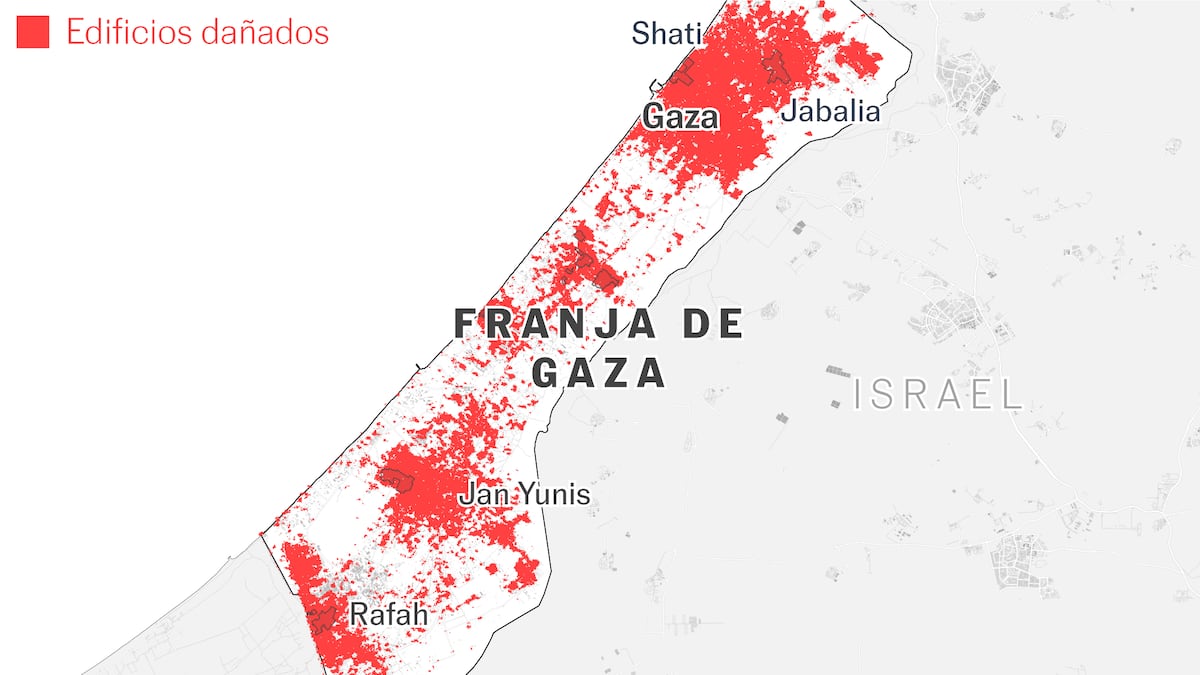data | Impact of a year of war in Gaza: unprecedented bombardment, deaths and destruction international

According to Hamas officials, a year into the war in Gaza, about 2% of the Strip’s residents have been killed in attacks by Israeli forces. This figure does not count the many dead – estimated at several thousand – who remained under the debris.
365 days after Hamas and other Palestinian armed groups crossed into Israeli territory and killed nearly 1,200 people, most of them civilians, Israel’s military operations in Gaza are causing a level of destruction unmatched in the world.
Bomb
In August 2017, the US-led coalition fighting the Islamic State carried out one of the largest bombing campaigns in recent history. It dropped 5,075 devices on Iraq and Syria, an average of 164 per day, seven bombs every hour. In Ukraine, during the first month of the Russian invasion, at least 3,007 bombings occurred, 100 per day.
These are extraordinary numbers, but as seen in the graph above, they are low compared to Israel’s airlift over Gaza. There is no official data on how many bombs were dropped in a year, but in November 2023, Israeli aviation reported conducting strikes against 22,000 targets. That means 846 attacks daily. At least two projectiles are launched in each bombardment.
As recalled in the magazine foreign Affairs Robert Pape, an American historian who has analyzed the largest bombings since World War II, said, “We are in the highest quartile of the most destructive bombing campaigns in history.”
This is also confirmed by air strikes resulting in civilian casualties. This is something that the international organization ACLED has been dedicated to documenting and verifying since 2015: in November 2023 attacks of this type in Gaza have exceeded the highest figure ever recorded in Syria.

death
How many people have died in Gaza? According to the results of the Uppsala Conflict Data Programme, an academic project dedicated to counting conflict victims, with only three months of war data in 2023, Palestine became the conflict with the highest number of deaths in the world that year. Its calculation for Gaza and the West Bank is 37,000 deaths by August this year, 22,600 of which occurred in the first three months of the war alone.
In the following graph we compare this number of deaths (partial, as it does not measure the entire year) with the highest number of deaths in other conflicts analyzed by that research center that year. It includes all deaths since 1989, whether civilian or military.
The Gaza Health Ministry has counted 41,788 deaths as of October. 40% of them were minors. This organization published a list of the names of all those who lost their lives in August for the third time since the beginning of the war (the first 14 pages of that report in Arabic were of children under one year old). The British organization Airwars has managed to verify the identity of about 80% of the deaths listed using open sources on the Internet.
The high number of deaths in Gaza is explained, in part, by the area that is being attacked: 2.2 million people live in the strip in an area of 365 square kilometres. This means that there are nine times more people living in one square kilometer of the enclave than in an area of similar size in Spain. Furthermore, in Gaza, almost one in two residents is under the age of 18, a ratio that explains why so many children are vulnerable to indiscriminate bombing.
Still, this is not the first time Israel has attacked the Strip and figures like the one seen last year have never been seen. “The main difference between previous conflicts between Israel and Gaza is scale,” says Jørgen Genshaugen, a researcher at the Oslo Peace Research Center (PRIO). “In previous wars in the Strip, like 2014, there was talk of a maximum of 2,000 deaths. But today, in addition to the estimated 41,000 deaths, we know that 10,000 people are missing. We’d be talking about Israel killing 2% of the population,” he recalls.
More destruction than Aleppo or Mariupol

Measuring the destruction of a city is complicated. Over the past decade, academics and historians have increasingly relied on analysis of satellite images comparing before and after the bombed city. Aleppo in Syria was one of the first places where destruction from this technology was recorded, for four years (2012–2016) the city was the center of the largest conflict between the Syrian government and the opposition. Then, UNITAR, the United Nations research center, calculated that 33,251 properties were damaged in the city, that is, between 50% and 65% of all properties there.
Now the same UN center estimates that 163,778 buildings have been destroyed in the entire Gaza Strip, or 66% of the total. An estimate from the University of Oregon (whose data is shown in the map at the top of this article) points to a similar figure: 58.7%. As seen in the graph above, it affects all types of infrastructure, from schools to hospitals.
In Mariupol, a Ukrainian city that was besieged by Russian forces for three months and a symbol of the war in that country, the same UN analysis estimated that 32% of all buildings were damaged.
The devastation in Gaza is not limited to the cities only. As also happened in Ukraine, crops are directly attacked: the University of Oregon estimates that between 64% and 70% of tree crop fields have been destroyed. As Genshaugen emphasizes, this allows us to see one of the other distinctive aspects of this war: “the level of destruction and the use of hunger as a method of warfare.” And he adds: “One logic has changed in the Israeli government with respect to past conflicts: the fact that destroying Hamas is a war objective.”
(TagstoTranslate)war
